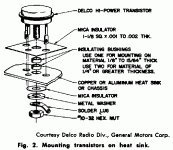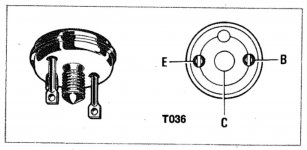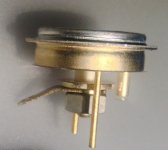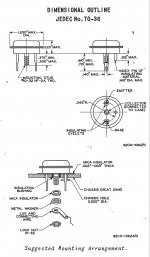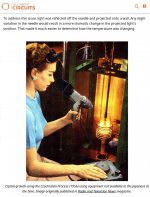If anyone is interested, there's a flat of 50 Bendix Germanium TO-3 power transistors on Ebay for a crazy good price, probably because the seller has no idea of the specs...
I regret passing on about 5 flats not long ago because they had no reference other than Western Electric stock #'s. From a local retired W.E engineer's leftovers.
Memories @Wrenchone, back in the 70's I had gig running biofeedback experiments at the Crippled Childrens Association in South Australia. Place was full of powered wheelchairs of course and the fancy types had a PWM speed control with relay controlled direction. The PWM outputs were TO3 Lansdales but I forget the p/n. They however withstood awful abuse and I was roped in to fix them when there was an occasional fail. 12V system and over 20A, probably closer to 30A to start rolling but no free-wheeling diodes to divert slow down generated volts - no other braking method alas. Suspect this was the cause of the failures.
probably because the seller has no idea of the specs...
And he is not alone 🙂 Do you have specs for b-1729a?
I've done some looking around myself, but with no joy so far... I may have some old Bendix and Solitron data in my stuff from school, but it would take a lot of digging (again in the basement) to find out.
Anyway, there is no shortage of NOS Germanium power transistors floating around currently on E-prey, many with specs available, and many at bargain prices (some not)
Anyway, there is no shortage of NOS Germanium power transistors floating around currently on E-prey, many with specs available, and many at bargain prices (some not)
..I found one of my old amps..
This beauty old school amplifier can be updated with some fresh components
PYE Transistor amp (Vintage 1964) Repair and test.
OK, I nosed around on E-prey and nailed down 22 pieces of Delco 2N1358 TO-36 transistors. Unlike the previously mentioned Bendix devices, the specs are readily available. Along with the other samples I have squirreled away in the basement, I'll have enough devices on hand for when I start my own investigations. I've been spoiled by working with mosfets, as these beasts actually demand a fairly substantial amount of drive current. If I can find some NPN germanium devices, I might try to set up a germanium-based buffered SIT emulation.
OK, I nosed around on E-prey and nailed down 22 pieces of Delco 2N1358 TO-36 transistors. Unlike the previously mentioned Bendix devices, the specs are readily available. Along with the other samples I have squirreled away in the basement, I'll have enough devices on hand for when I start my own investigations. I've been spoiled by working with mosfets, as these beasts actually demand a fairly substantial amount of drive current. If I can find some NPN germanium devices, I might try to set up a germanium-based buffered SIT emulation.
How do you heatsink those devices?
With a heat sink, of course - spot the holes using one of the insulators, and in a pinch, use a TO-3 shoulder washer to insulate the collector connection. The locator pin will also need a touch of heat shrink for insulation, as all the plastic sleeves used for that purpose have likely long disappeared from the market.
Last edited:
If you do some semi-diligent searching around on E-prey, you can find Keystone TO-36 mounting kits for a decent price - I just nailed down a few. I also have some TO-36 silpads floating around in my stash somewhere.
..If I can find some NPN germanium devices, I might try to set up a germanium-based buffered SIT emulation.
Hey that ambitious amplifier project!
Start with simple "pentodish" class A 5 ~ 15 watt's are all ready a build challenge.
After that SIT emulation can be interesting experiment with Schade feedback trick.
Ge NPN polarisation power transistor was produced ?
Attachments
The fake SITs are not such a big deal for me these days. I have a fake SIT + Aleph headphone amp in the works currently, that will also morph into a 5-10W Class A amp. I may send a proto to Papa to see if it will tickle his Tannoys sweetly.
As for Germanium, I may try a fake SIT Darlington with a Si input stage to ease drive requirements.
As for Germanium, I may try a fake SIT Darlington with a Si input stage to ease drive requirements.
How do you heatsink those devices?
Off the shelf heat sinks were common, and you could always rip the heat sink off the back of a late 50's - early 60's car radio.....with its germanium transistor. I worked as the repair tech in an Olson's Electronics store in 1971 and 1972. I remember selling Motorola branded heat sinks for these parts.
Google just told me the part numbers. It was a Motorola MS-15 or a HEP 501. There are a couple on Ebay. I had a couple with some HEP transistors on them when I was in Florida, but I probably gave them to the scrap guy when I had to move out on 3 weeks notice. About 800 pounds of transformers went to the melting house too.
Motorola MS-15 Black Anodized Alunimum Heat Sink TO-36 Holes & Hardware HEP501 | eBay
NEW! Vintage Motorola TO-36 Power Transistor MS-15 Heat Sink NOS | eBay
Motorola Power Transistor TO-36 and Heat Sink MS-15 w/ Mounting Kit *NEW | eBay
If I can find some NPN germanium devices
Ge NPN small signal parts were made, but not too common. I never saw a Ge NPN power transistor.
We sold an Italian made Voxon stereo at Olsons in the early 70's. It used a complementary pair output for 20 WPC. one transistor was an NPN Si, the other was a PNP Ge. Guess which one blew? I replaced it with a HEP230, it didn't blow. I changed so many, I still remember the number. I had a pair of those old Voxson stereos myself. They sounded pretty good with a few tweaks.
The HEP 230 was a pretty stout device, far harder to kill than the 2N2147 even when the Dumm Blonde plugs his guitar into it and cranks it to 11.
I remember european complementary pairs AC187/AC188 and AD161/AD162 for "ironless" power stages upto several watts.
That would be interesting, doing a fake SIT using a quasi-complementary pair. Since the Ge power devices are generally slower than molasses on a chilled plate, I don't think I'll have to worry about parasitic oscillations, something that caused me to abandon quasi-complementary outputs in favor of Darlingtons early in my career.
I just got my TO-36 hardware kits in the mail. There is no sleeve included for the locator pin on the bottom of the package. I'm going to need to check some of the TO-36 packages I have in the basement to see if the locator pin is already insulated. The JEDEC spec says it should be, but we'll see. If not, the pin could easily be covered with some heat shrink.
Doing a digital multi meter test on the Ge parts can really get you scratching your head.
I've done some looking around and there are some suggestions out there but the DMM readings I was getting didn't always agree with what I thought I should get.
I finally built up a circuit that is shown on the youtube channel "radiofun232". The video title is "Test circuit for (PNP) germanium transistors with a relaxation (hik) oscillator" and is from three years ago. If you don't have a curve tracer this circuit allows you to quickly and easily test Ge transistors to see that they are working.
His channel is a little funky and low tech looking but makes the subject accessible and has good info. PaPa's comments on the devices made me very curious about the sound of germanium transistors also so I built radiofun232's AC188 / AC187 amplifier and like it very much. It is surprising what a watt or two can do.
As I don't have a lot of experience building amps (though I have built a few-no expert)
it was a bit of a challenge. Turns out germaniums are pretty sensitive to bias so I had to play around with some values and add a compensation diode to drive out some cross over distortion. I learned more from having to research this little amp then most bigger and well documented builds.
If your thinking about a germanium build I would say it's worth the effort.
Thanks Woofertester for starting this discussion.
I've done some looking around and there are some suggestions out there but the DMM readings I was getting didn't always agree with what I thought I should get.
I finally built up a circuit that is shown on the youtube channel "radiofun232". The video title is "Test circuit for (PNP) germanium transistors with a relaxation (hik) oscillator" and is from three years ago. If you don't have a curve tracer this circuit allows you to quickly and easily test Ge transistors to see that they are working.
His channel is a little funky and low tech looking but makes the subject accessible and has good info. PaPa's comments on the devices made me very curious about the sound of germanium transistors also so I built radiofun232's AC188 / AC187 amplifier and like it very much. It is surprising what a watt or two can do.
As I don't have a lot of experience building amps (though I have built a few-no expert)
it was a bit of a challenge. Turns out germaniums are pretty sensitive to bias so I had to play around with some values and add a compensation diode to drive out some cross over distortion. I learned more from having to research this little amp then most bigger and well documented builds.
If your thinking about a germanium build I would say it's worth the effort.
Thanks Woofertester for starting this discussion.
- Home
- Amplifiers
- Pass Labs
- Germanium investigations
